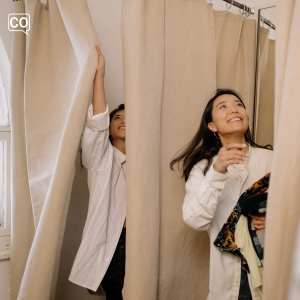Learn how to talk about clothing styles in German with practical vocabulary like "das Outfit" (outfit), "der Anzug" (suit), and "die Jacke" (jacket). Practice discussing fashion choices for work and everyday wear to enhance your conversational skills.
Vocabulary (13) Share Copied!
Exercises Share Copied!
These exercises can be done together during conversation lessons or as homework.
Exercise 1: Dialogue Cards
Instruction: Select a situation and practice the conversation with your teacher or fellow students.
Exercise 2: Multiple Choice
Instruction: Choose the correct solution
1. Die Verkäuferin ___ dich gerne, wenn du Fragen hast.
(The saleswoman ___ you gladly when you have questions.)2. Ich ___ meinen Freund, welche Marke gut ist.
(I ___ my friend on which brand is good.)3. Letzte Woche ___ er sich schnell ___, um die neue Kleidung anzuprobieren.
(Last week ___ he quickly ___ to try on the new clothes.)4. Wir ___ uns in der Umkleidekabine umgezogen und fühlen uns jetzt bequem.
(We ___ in the fitting room and now feel comfortable.)Exercise 3: A Shopping Day with Style Advice
Instruction:
Verb Tables
Beraten - To advise
Perfekt
- ich habe beraten
- du hast beraten
- er/sie/es hat beraten
- wir haben beraten
- ihr habt beraten
- sie/Sie haben beraten
Haben - To have
Perfekt
- ich habe
- du hast
- er/sie/es hat
- wir haben
- ihr habt
- sie/Sie haben
Sein - To be
Perfekt
- ich bin
- du bist
- er/sie/es ist
- wir sind
- ihr seid
- sie/Sie sind
Sich ausziehen - To take off (clothes)
Perfekt
- ich habe mich ausgezogen
- du hast dich ausgezogen
- er/sie/es hat sich ausgezogen
- wir haben uns ausgezogen
- ihr habt euch ausgezogen
- sie/Sie haben sich ausgezogen
Stehen - To stand
Präsens
- ich stehe
- du stehst
- er/sie/es steht
- wir stehen
- ihr steht
- sie/Sie stehen
Don't see progress when learning on your own? Study this material with a certified teacher!
Do you want to practice German today? That is possible! Just contact one of our teachers today.
Clothing Styles and Fashion – German Lesson Overview
This A2-level lesson focuses on vocabulary and expressions related to clothing styles and fashion, helping learners discuss outfits, shopping for clothes, and personal styles in everyday situations.
Lesson Content and Key Topics
- Talking about office attire: Learn to describe what you wear to work and explain your choice, e.g., "Ich habe eine blaue Bluse und eine schwarze Hose an" (I am wearing a blue blouse and black pants).
- Shopping conversations about clothing: Practice asking for help in a store and describing your favorite clothing items, for example, asking for a "schwarze Jacke" (black jacket) that is warm yet light.
- Discussing everyday clothing style: Express your daily fashion preferences and reasons, such as liking casual wear or preferring classic outfits.
Useful Vocabulary and Expressions
- das Outfit – outfit
- bequem – comfortable
- der Anzug – suit
- die Jacke – jacket
- schick – stylish
- modern – modern
- preiswert – good value
Important Practice Areas
The lesson includes dialogues for conversational practice, highlighting practical language use, such as compliments, preferences, and questions about clothing items and styles. Verb conjugations focus on relevant verbs like beraten (to advise), ausziehen (to take off clothes), and auxiliary verbs haben and sein in perfect tense, important for describing past actions related to clothing.
Grammar Highlights
Key verbs in this lesson often use the perfect tense to describe recent activities, e.g., "Ich habe mich umgezogen" (I changed clothes). The lesson provides conjugation tables for these verbs to aid understanding and correct usage.
Language and Instruction Notes
Since the lesson is taught in English and the target language is German, translations are provided for vocabulary and phrases to aid comprehension and new word acquisition. Unlike languages with more similar vocabulary to English, German often uses compound nouns and separable verbs which are important to recognize and practice—for example, "sich ausziehen" (to undress) separates in sentences. Useful phrases include:
- Wie viel kostet sie? – How much does it cost?
- Kannst du mir helfen? – Can you help me?
- Ich bevorzuge – I prefer
Understanding these examples helps learners express preferences and ask questions naturally in German.























